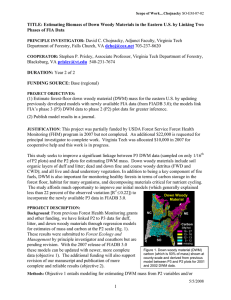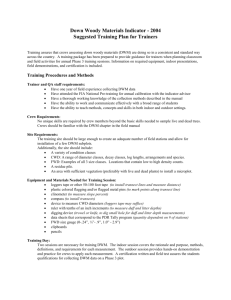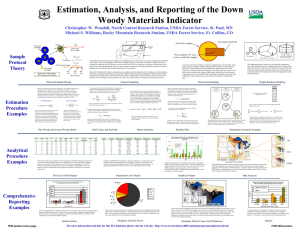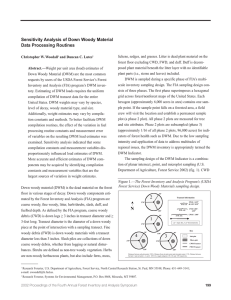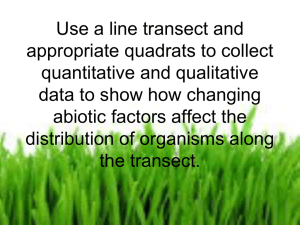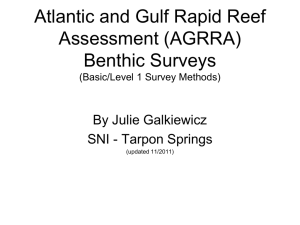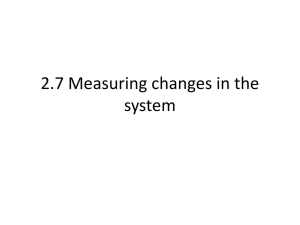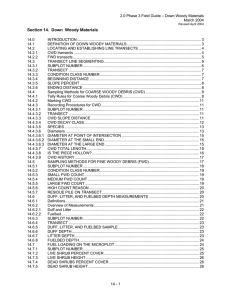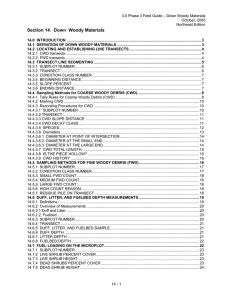FWD
advertisement
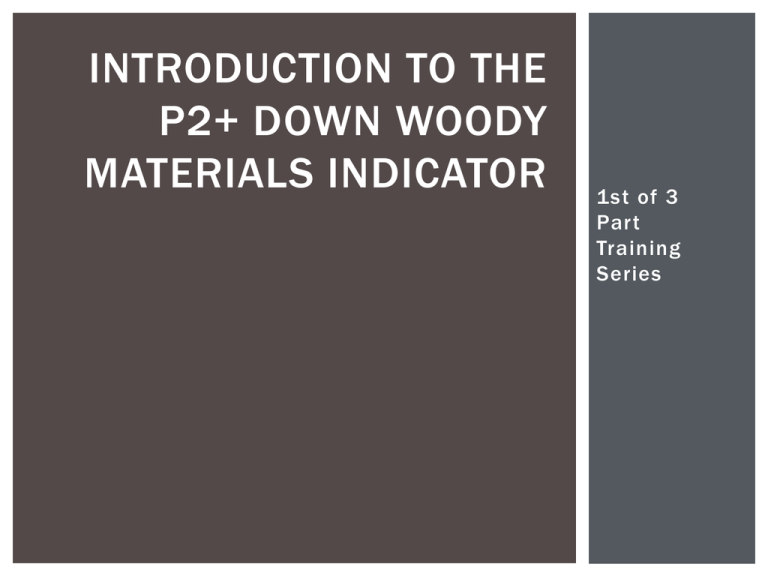
INTRODUCTION TO THE P2+ DOWN WOODY MATERIALS INDICATOR Christopher Woodall 1st of 3 Part Training Series OUTLINE Why Collect DWM data? What is P2+ DWM? What are Down Woody Materials? Sampling Design Theory WHY COLLECT DWM DATA? Forest Structure Wildlife Habitat Fuel Loading Carbon Stocks Nutrient Cycles FOREST STRUCTURE Measure structural attributes missed by phase 2 Coarse Woody Debris Fine Woody Debris Litter Duff WILDLIFE The DWM Inventory describes the amount and condition of wildlife habitat WILDLIFE 2000 1800 1600 1200 1000 3 ft /a c re 1400 800 600 400 200 0 Il IN IA KS MI MN MO NE ND SD WI S ta te Mean estimates of CWD volumes for forests of the North Central Region WILDLIFE 1% 6% 14% 20% 1% 33% 1 7% 68% 40% A B T ra n se ct D i a m e te r (in ) 3 .0 -7 .9 8 .0 -1 2 .9 1 3 .0 -1 7 .9 1 8 .0 + De ca y Cla ss 1 2 3 4 5 Proportions of coarse woody debris pieces per acre by transect diameter (A) and decay class (B) (1=least decayed, 5=most decayed), Indiana, 2001-2003 FUELS 1-hr 10-hr 100-hr Total Fine Woody Debris FIRE SCIENCE LANDFIRE: National Mapping of Fuel Loadings Fuels Management: Allocation of Fuel Management Funding Resource Assessments: Relationships to ownership and management Forest Vegetation Simulator Fuel Estimates CARBON STOCKS Climate Negotiations Wood energy policies and availability Climate change mitigation DWM AND OTHER PLOT MEASUREMENTS Completes inventory of trees from living, to dead, to fully decomposed Microplot Sapling Sub-plot Tree Sub-plot Standing Dead DWM Down and Dead FUTURE OF DWM MEASUREMENT Declining Budgets DWM Measurement Critical to Numerous Resource Assessments Major User Groups Request Continued Collection of DWM = A More Efficient version of P3 DWM aka P2+ WHAT IS DWM P2+? Collect detailed DWM data on a few plots Vs Collect only most important DWM data on many plots THEORY BEHIND P2+ May better meet user’s needs using a “rapid” protocol to measure most requested data items on a “substantial” panel of plots: Fuel loadings (including piles) Carbon stocks (including fine woody debris) Biomass assessments Use QA/QC information and user/field crew feedback to improve/remove variables WHAT WAS DROPPED FROM PREVIOUS P3? Fuelbed Depth All microplot measurements CWD end-point and length measurements One transect per subplot WHAT WAS REVISED? Transect locations Only 2 transects per subplot Slash piles measured along transect Only CWD attributes at point of intersection measured Non-sampled statuses for numerous components BEHOLD NEW PLOT DESIGN FWD < 0.25”& 0.26 – 0.9” 360 2 FWD 1.0 – 2.9”” 180 CWD ≥ 3.00” N 6 ft. HD. 10 ft. HD. 24 ft. HD 1 HD.=horizontal dist. 90 270 Subplot 4 225 45 315 3 135 CWD Transect FWD Transect Duff/Litter Sample Points Subplot Center WHY THE NEW TRANSECTS? Avoids transect orientation bias while reducing number of transects…imagine it as one big “Y” transect from old P3 design 360 2 180 N Final subplot 1 transect balances larger “Y” orientation 1 90 270 4 225 45 315 3 135 DEFINITION OF DWM STAYS THE SAME Dead material within forests in various stages of decay such as fallen trees, branches, and leaf litter The FIA program places numerous forest ecosystem components into the DWM Indicator DWM COMPONENTS Coarse Woody Debris Fine Woody Debris Litter Duff Slash COARSE AND FINE WOODY DEBRIS Transect Diameter Class Name 0.00-0.24 inches Small FWD 0.25-0.99 inches Medium FWD 1.00-2.99 inches Large FWD 3.00+ inches CWD FUEL-HOUR CLASSES Transect Diameter Class Name Hour-Class Small FWD 1-hour Medium FWD 10-hour 1.00-2.99 inches Large FWD 100-hour 3.00+ inches CWD 1000+-hour 0.00-0.24 inches 0.25-0.99 inches DUFF AND LITTER “dead plant material on forest floor surface” “unrecognizable plant parts” SLASH/RESIDUE PILES Piles of CWD DWM SAMPLING THEORY DWM Component Sampling Design CWD, FWD, Slash Piles Transect Duff and Litter Simple Random Sampling at Specified Points in Sub-plot DWM diversity requires a diversity of sampling methods DEPTH ESTIMATES ON SUBPLOT In order to estimate depth of duff and litter on a subplot… Litter 8 sample points located for measurement on subplots at the end of each transect Duff DEPTH ESTIMATES ON SUBPLOTS 360 2 Sample Locations 180 N 1 90 270 4 225 45 315 3 135 DEPTH SAMPLING STATUS If point covered in snow or water it can now be indicated and not sampled However, if rock or log is at point then it is sampled with potentially no duf f/litter at location Old P3 Calculation P2+ Calculation 11 points with rocks = null 1 point with deep litter = 5 inches 11 points with rocks = 0 1 point with deep litter = 5 inches Plot Average = 5 inches Plot Average = 0.4 inches Potentially Biased! TRANSECT SAMPLING FWD and CWD pieces are not all counted within a given area rather… All FWD and CWD pieces that intersect a sampling plane are tallied TRANSECT SAMPLING Probability of match stick intersecting randomly placed line related to number of sticks and length of line TRANSECT SAMPLING PLANES Intersectin g S am pling P lane C W D P ieces Fuel B ed DWM Sample Protocol establishes sampling transects that radiate from FIA subplot centers to intersect fine and coarse woody pieces CWD AND FWD TRANSECTS 360 2 180 N 1 90 270 4 225 45 315 3 135 Use 2 transects established on each subplot to sample CWD, one transect on each subplot to sample FWD ONLY MEASURE PIECE INFORMATION AT POINT OF INTERSECTION Transect imaginary sampling plane VOLUME/BIOMASS ESTIMATION FROM JUST TRANSECT MEASUREMENT? We have only been using transect diameter for fine woody debris estimation for over a decade…now we apply similar estimator to coarse woody debris 2 43560 8 yd 144 4 K j n 2 jk Q M D I jk j 1 k 1 4 L j 1 jd s jd jkd BRINGING IT ALL TOGETHER FWD < 0.25”& 0.26 – 0.9” 360 2 FWD 1.0 – 2.9”” 180 CWD ≥ 3.00” N 6 ft. HD. 10 ft. HD. 24 ft. HD 1 HD.=horizontal dist. 90 270 Subplot 4 225 45 315 3 135 CWD Transect FWD Transect Duff/Litter Sample Points Subplot Center CONCLUSIONS • The DWM indicator estimates numerous ecosystem components • Data Crucial to Fire, Carbon, and Wildlife Sciences • Integral Part of National FIA Program, Completes Tree Life Cycle • A variety of sampling techniques for estimation of various DWM components •P2+ should be more efficient and robust QUESTIONS Blast from Past P3 National Training Macon, GA 2002
